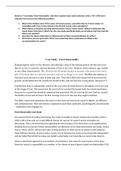Unit 4B: Making a nail varnish remover
Ethyl ethanoate:
Introduction:
Ethyl ethanoate, which is also known as ethyl acetate is an organic compound with the chemical formula
C4H8O2. It is a colourless liquid with a unique sweet smell that is similar to the smell of some glues or
nail polish removers. It is an ester formed by the reaction of ethanol and acetic acid. It is widely used in
various industrial and laboratory applications due to how effective it is as a solvent and being of low
toxicity in comparison to other solvents.
Uses of Ethyl Ethanoate:
As discussed above it is widely used in various industrial and laboratory applications due to its
effectiveness as a solvent and properties some uses are:
1. Solvent in paints and coatings: Ethyl ethanoate is widely used as a solvent in the production of
paints, varnishes, and lacquers. It helps dissolve the resins, pigments, and other components,
ensuring a smooth application and even finish.
2. Adhesives and inks: It is an effective solvent for adhesives and printing inks, as it provides the
right consistency for application and helps with the quick drying of the final product.
3. Flavouring agent: In the food industry, ethyl ethanoate is used as a flavour enhancer due to its
pleasant, fruity aroma. It is commonly found in sweet treats, baked goods, and drinks to
improve their taste.
4. Pharmaceuticals: Ethyl ethanoate is used in pharmaceutical manufacturing to extract active
ingredients from plants and other sources.
5. Perfumes and fragrances: Due to its ability to dissolve and blend various aromatic compounds,
ethyl ethanoate is used in producing perfumes and fragrances.
6. Reagent: In chemical laboratories, ethyl ethanoate is used as a reagent and solvent for various
organic reactions, extractions, and purifications.
7. Cleaning products: It is found in some cleaning products due to its ability to dissolve oils and
other residues which makes it effective for cleaning surfaces and equipment.
Structural formula:
, The structural formula of ethyl ethanoate is CH3COOCH2CH3. It consists of an ester functional group
(COO) linking an ethyl group (CH2CH3) and an acetyl group (CH3CO). The structural representation can
be drawn as:
Manufacturing techniques:
Reflux:
Reflux is a laboratory technique used for heating a reaction mixture for a long period of time without
losing volatile components to the atmosphere. It involves continuously boiling the reaction mixture and
condensing the evaporated vapours back into the reaction vessel. This allows for more thorough mixing
and reaction between the reactants.
Principles:
1. Heat application: The reaction mixture is heated to its boiling point to initiate and sustain the
chemical reaction.
2. Condensation: Vapours produced by the boiling reaction mixture rise into the condenser, where
they are cooled by a continuous flow of cold water, causing them to condense back into liquid
form.
3. Return of the liquid: The condensed liquid flows back into the reaction vessel, ensuring that no
reactants or products are lost during the reaction.
4. Closed system: Maintains a closed system that allows the reaction to proceed for an extended
period without loss of volatile components.












